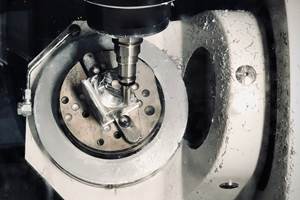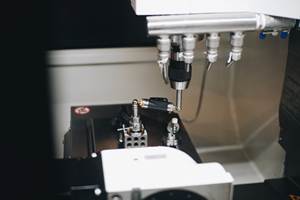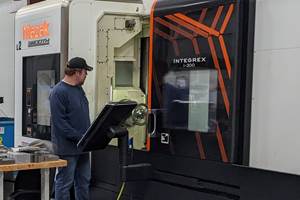Shop Hits Home Run with Toolpath Simulation Software
Wolcott Design Services needed to improve efficiency during high-mix, low-volume runs. HMCs and Vericut tool simulation software by CGTech improved efficiency, spindle utilization and revenue.
Share





Competing as a small job shop means running as efficiently as possible, but the investments Wolcott Design Services of Newberg, Oregon, made to improve its production process also made it vulnerable. Adding a high-end horizontal machining center meant risking expensive repairs if a tool were to crash, and further investments in software seemed like a gamble. However, after using toolpath simulation software from CGTech (Irvine, California), Wolcott found ways to streamline its production and safeguard its new investments.
Bob Wolcott, a former pitcher for the “refuse-to-lose” 1995 Seattle Mariners, founded Wolcott Design Services in 2005 with a single vertical machining center, performing prototype research and development for the high-tech industry. Making complex parts necessitated the addition of a trunnion-style, five-axis table for the VMC. He carefully grew his high-mix, low-volume business with the addition of a second VMC with five-axis capabilities. But as the business grew, he realized the limitations of his equipment. “We just weren’t running as efficiently as we needed to be,” he says. “Jumping from job to job with such short production numbers was a challenge, so I bought a high-end HMC, which gave us a lot more flexibility.”
The ability to set up multiple jobs on different tombstones or even different faces of the same tombstone seemed like a home run for Wolcott’s three-man team, but the HMC’s price tag gave Mr. Wolcott pause. A simple mistake on this machine could cost tens of thousands of dollars, and a major crash could cost more than one of his VMCs—that’s without calculating the cost of downtime, he says. “I needed peace of mind. I had to make sure that would never happen.”
This is when CGTech’s Vericut stepped up to the plate. Mr. Wolcott had used a competing brand of toolpath simulation software on his verticals, but that system ran foul. With a much more expensive machine at stake, he invested in Vericut software and gradually realized that its benefits went beyond avoiding accidents. “When we implemented Vericut, the initial goal was just to avoid crashes,” he says. “I saw it as an insurance policy on the more expensive machines.” However, as his single HMC grew to three, one of which is part of a 12-pallet flexible manufacturing system (FMS), the company unlocked more of the software’s features, and its benefits grew considerably.
All the HMCs are part of the same cell controller and all use Vericut. A typical project might run for a day or as long as a week, but it will run in parallel with several other projects, Mr. Wolcott says. “We turn stuff around pretty quickly because our setups are basically nonexistent.”
“...we knew that when we come in the next day we’ll have good parts.”
It took some effort to get to this point. Over the past six years, the team has modeled every machine, toolholder and fixture in the system to a thousandth of an inch. Every machine shares the same tool library, which is stored in Vericut. For instance, the 0.5-inch, four-flute carbide end mill that defines tool 7 on machine 1 will have the same definition on machines 2 and 3, with the same holder and stick out, Mr. Wolcott says. Cutting tools are preset offline, touch probes are used to check machine features in process, lasers are used to check for tool breakage, and the CAM system’s postprocessor has been customized to fit the shop’s needs. “It’s a complete package,” he says.
Since the company implemented these measures, shop-wide spindle utilization has become roughly 70 percent over a 24-hour period, though Mr. Wolcott sees that rate increasing in the future as its FMS is used at a higher capacity. And when the shop is “running hard,” he says he has seen 98-percent uptime, thanks in part to Vericut.
Because the software enables him to catch problems on the computer while the machine is making parts, he can avoid costly mistakes. “Vericut tells us when the machine is going to over-travel or trigger an alarm,” he says. He is not scrapping out expensive chunks of material or having to revamp programs while the machine is sitting idle, either.
The HMCs keep making chips as his team performs the preparation work for the next job. According to Mr. Wolcott, he feels so confident in his production process that he is comfortable going into extra innings: running new programs overnight after testing them in the software. He says, “It might run at midnight or it might run at 4 a.m., but we know that when we come in the next day we’ll have good parts.”
Related Content
6 Machine Shop Essentials to Stay Competitive
If you want to streamline production and be competitive in the industry, you will need far more than a standard three-axis CNC mill or two-axis CNC lathe and a few measuring tools.
Read MoreHow to Successfully Adopt Five-Axis Machining
While there are many changes to adopt when moving to five-axis, they all compliment the overall goal of better parts through less operations.
Read MoreBallbar Testing Benefits Low-Volume Manufacturing
Thanks to ballbar testing with a Renishaw QC20-W, the Autodesk Technology Centers now have more confidence in their machine tools.
Read More5 Tips for Running a Profitable Aerospace Shop
Aerospace machining is a demanding and competitive sector of manufacturing, but this shop demonstrates five ways to find aerospace success.
Read MoreRead Next
How I Made It: Dennis Rymanowski
Dennis Rymanowski has worked at NSH USA for 60 years, with his passion for manufacturing living alongside his passion for his family’s polka band.
Read MoreA New Frontier in Surface Finish Control
What if your machine tool could measure surface roughness as it cuts? This article explores how in-process metrology is advancing from concept to reality, enabling real-time feedback, immediate detection of anomalies and new levels of control over surface quality. Discover the technologies making this possible.
Read More























